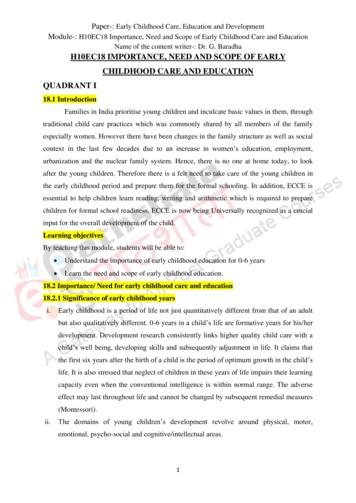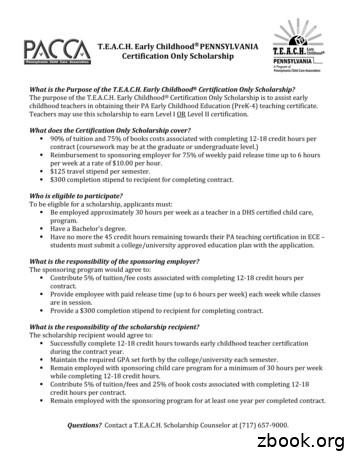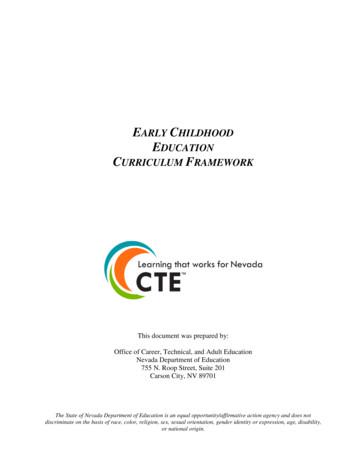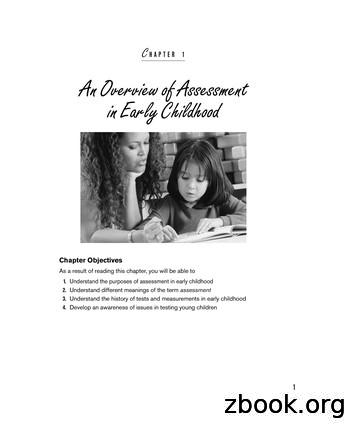New Mexico Early Childhood Transition
New MexicoEarly Childhood TransitionTransition Team Tool KitCenter for Development & Disability at University of New Mexico 2300 Menaul NE Albuquerque, NM 87107-1851Phone 505.272.3000 Fax 505.272.5280University Center for Excellence in Developmental Disabilities Education, Research and ServiceRevised 9-15-2020
Transition Team GuideWelcome to the Early Childhood Transition Team. This tool kit was developed to help support youin being successful in your role as a member on the transition team.The tool kit is divided into the following sections:I.The New Mexico Early Childhood Transition Initiativea) Introduction to: The New Mexico Early Childhood Transition Initiativeb) Why Have a Family Member on the Team?c) Family Advisory Roled) Who’s Who on the Team?e) Team Roles and Responsibilitiesf) Potential Team Rolesg) Transition Team Memorandum of Understanding (MOU)II.Early Childhood Partnersa) Early Childhood Services1. Early Intervention, Birth – Age 3 (Part C)2. Public Education - Special Education, Age 3 -21 (Part B)b) Early Head Start / Head Startc) NM State Supported SchoolsIII.Transition Team Meetingsa) Getting Ready for Transition Team Meetingsb) Things to Consider When Attending a MeetingIV.Communicating with the Teama) Communication is the Keyb) How to Handle Conflict When You See ItV.Confidentialitya) Family Education Rights and Privacy Act (FERPA) &Health Insurance Portability and Accountability Act (HIPAA)VI.Resourcesa) Frequently Used Acronymsb) ResourcesVII.Miscellaneousa) ReferencesYour role as a transition team member will make a difference!Center for Development & Disability at University of New Mexico 2300 Menaul NE Albuquerque, NM 87107-1851Phone 505.272.3000 Fax 505.272.5280University Center for Excellence in Developmental Disabilities Education, Research and ServiceRevised 09-15-2020
Introduction to:New Mexico Early Childhood Transition InitiativeMission: To support transition teams in developing and/or improving transitionprocesses for children and families from early intervention services to other communityservices & supports.Purpose: The primary purpose of community-based transition teams is to ensure thatfamilies and their children experience a smooth & effective transition from earlyintervention services to community services & supports. They do this by meetingfrequently to discuss early childhood transition and reviewing the agreed upon process.Transition Teams provide guidance on:How to foster smooth & effective transitions for familiesTransition related roles &responsibilitiesDevelopment of community-based systems of transition throughinteragency and family collaborationCommunity-based transition teams: 30 Teams in New Mexico including: Family Leaders School Districts/Local Education Agencies (LEAs) Early Intervention Providers (EI) Head Start/Early Head Start (HS/EHS) Home Visiting Providers (HV) Bureau of Indian Education (BIE) Parents Reaching Out (PRO) Education for Parents of Indian Children with Special Needs (EPICS) New Mexico School for the Deaf (NMSD) New Mexico School for the Blind and Visually Impaired (NMSBVI) Child Care ProvidersThrough the efforts of the transition team an agreement is developed that outlines theprocess for transitioning children from early intervention to community programs &supports. This agreement is called a Memorandum of Understanding (MOU). Thepartners acknowledge agreement with the MOU through their signatures. Each team inNew Mexico has an agreement (MOU) which is reviewed annually for revisions andimprovements. The family team member’s participation on the team is vital in creating,implementing, and reviewing the MOU.Center for Development & Disability at University of New Mexico 2300 Menaul NE Albuquerque, NM 87107-1851Phone 505.272.3000 Fax 505.272.5280University Center for Excellence in Developmental Disabilities Education, Research and ServiceRevised 09-15-2020
Why Have Family Members on theEarly Childhood Transition Team?In New Mexico families are joining earlychildhood transition teams and realizing theimpact and influence they can have in shapingpolicies and programs. Providers recognize thatfamily involvement is integral to designing aservice system that is responsive, welcoming,and effective.Parent participation on teams provides teammembers with a valuable insight into thetransition process and the parent perspectivethat supports a shared understanding and helpsimprove positive experiences and processes throughout early childhood transition.A commitment of time is expected. Because you are representing the family perspective on the transitionteam, it is important that you’ve recently gone through the transition process. The frequency and time foreach team’s meeting may vary. Talk with your team leader/mentor to get more information.Center for Development & Disability at University of New Mexico 2300 Menaul NE Albuquerque, NM 87107-1851Phone 505.272.3000 Fax 505.272.5280University Center for Excellence in Developmental Disabilities Education, Research and ServiceRevised 09-15-2020
Family Advisory RoleWhy is it important to have your voice at the Early Childhood Transition Team table?As the parent of a young child with special needs, who has transitioned to preschool or otherservices, you are uniquely qualified to offer Transition Team members information about theperspective of what may or may not work for families. You provide insight on a family’s experiencesas they transition from early intervention services into other programs.Early Childhood Transition teams benefit from the information you share to help guide the transitionprocess to meet families’ needs and priorities and to ensure smooth transitions.WHAT YOU WILL DO Network with other families in your community to learn about their experiences withtransition Represent families’ transition needs Share the family perspective Share the family culture and beliefs Identify challenges in the transition process Recommend solutions to resolve challenges Identify potential family advisors Understand your commitment of time (each teams’ schedule varies – your teamleader/mentor can provide more information)Center for Development & Disability at University of New Mexico 2300 Menaul NE Albuquerque, NM 87107-1851Phone 505.272.3000 Fax 505.272.5280University Center for Excellence in Developmental Disabilities Education, Research and ServiceRevised 09-15-2020
Who’s Who on the Team?Early Intervention Coordinator (FIT Provider) — often the team leaderPublic schools representatives — often the Special Education Directorand/or Early Childhood Coordinator or designated administrativerepresentative with decision-making authorityHead Start — often the Disabilities Coordinator from area Head Start(s)Representatives from the following MAY attend:New Mexico School for the Deaf/Parent Infant Child ProgramNew Mexico School for the Blind & Visually ImpairedEarly Head Start (EHS) / Head Start (HS)Education for Parents of Indian Children with Special Needs (EPICS)Home Visiting (HV)Parents Reaching Out (PRO)Family Leader(s)Community child care/preschool providersRegional Education Cooperative (REC)Center for Development & Disability at University of New Mexico 2300 Menaul NE Albuquerque, NM 87107-1851Phone 505.272.3000 Fax 505.272.5280University Center for Excellence in Developmental Disabilities Education, Research and ServiceRevised 09-15-2020
NM Early Childhood Transition InitiativeTransition TeamRoles and Responsibilities(Roles can be combined, rotated, or individualized to meet team needs)Coach’s Role & Responsibilities: Support team(s) in achieving the team’s shared mission and vision for smooth and effective transitions forchildren and familiesEnsure team members understand the Vision & Mission of the NM Early Childhood Transition Initiative andfacilitate an understanding of the transition process among and between systemsFoster collaboration and relationship buildingFacilitate the interagency process and partnership and assist teams in working through barriersAddress technical assistance needs; secure appropriate resource(s).Encourage parent involvement and foster a family focusServe as a resource in the development of interagency agreementsAssist teams in recognizing and celebrating accomplishmentsFoster sustainabilityIdentify issues relevant to the system and keep the NM Early Childhood Transition Coordinator informedPromote continuous improvementTeam Leader’s Role & Responsibilities: Ensure all agencies are represented on the teamFoster parent involvement on teamSchedule team meetings on a regular basisCoordinate the logistics for meetingsDevelop agenda and send out agenda prior to the meetingEnsure members are adequately informedMaintain copy of the Memorandum of Understanding (MOU) or Interagency AgreementTeam Facilitator: Facilitates the team meetingSupports the family voice at each team meetingSupports the voice of all team members at each team meetingSupports teams in following the team’s ground rulesTeam Note Taker: Maintain written record of meeting activityDisseminate written record to all team partnersEnsure shared communicationsTeam Time Keeper: Support team in starting and ending on timeSupport facilitator in tracking time in relation to the agendaTeam Mentor: Utilize Family Mentoring Guide to support and mentor family members onto the teamSupport and mentor new agency members onto the teamOther: Any other roles that might be unique to a particular teamCenter for Development & Disability at University of New Mexico 2300 Menaul NE Albuquerque, NM 87107-1851Phone 505.272.3000 Fax 505.272.5280University Center for Excellence in Developmental Disabilities Education, Research and ServiceRevised 09-15-2020
Potential Team RolesRoleTeam Coach-Technical Assistance-Resource for team members-Team process supportName of Team Member(s)Team Leader- Schedule/location for team meetings- Update member list including contact information- Develop & send out agenda using members’contributions- Coordinate communication- Foster family involvementFacilitator-Facilitate meetings-Support family voiceNote Taker- Maintain written record of meetings- Disseminate to team membersTime Keeper-Support team in starting and ending on time-Support facilitator in tracking time in relation toagendaMentor(s)-Family Mentor-New Agency Mentor-Support new members onto the teamOtherGeneral membership:-Regularly attend-Contribute agenda itemsCenter for Development & Disability at University of New Mexico 2300 Menaul NE Albuquerque, NM 87107-1851Phone 505.272.3000 Fax 505.272.5280University Center for Excellence in Developmental Disabilities Education, Research and ServiceRevised 09-15-2020
MEMORANDUM OF UNDERSTANDINGCONCERNINGTHE TRANSITION OF CHILDREN BETWEEN(Fit Early Intervention Agency) and(Local Education Agency)Following the heading is a description of the involved agencies entering into the agreement and theservice each represents, such as Head Start, Local Education Agency, Early Intervention, StateSupported Schools, etc.I.PURPOSEThis is an important part of the MOU. It sets the stage and tone of the contents and agreements.II.REQUIREMENTS IMPACTING THIS AGREEMENTList Federal and/or State transition laws and any other agency transition requirements.III.DEFINITION OF TERMSProvide definitions of terms that will be used throughout the agreement.IV. IMPLEMENTATION OF AGREEMENTHow will copies of the agreement be provided to those who will use it in the transition process?V.MONITORING AND EVALUATION OF THE AGREEMENTWhen and how will the effectiveness be evaluated? How will changes be made and what criteria will beused to evaluate that the agreement is a valid, functioning part of the transition system?VI.INTERAGENCY DISPUTE PROCESSDetails of how disputes/conflicts between the agencies signing this agreement will be resolved.VII.DURATIONBeginning and ending dates of this agreement and when reviews will take place to update theagreement.VII.WORKING PROCEDURES, TIMELINES AND RESPONSIBILITIES IN TRANSITION PROCESSWhat, when, where, how and who is responsible for the various steps in the transition process.Center for Development & Disability at University of New Mexico 2300 Menaul NE Albuquerque, NM 87107-1851Phone 505.272.3000 Fax 505.272.5280University Center for Excellence in Developmental Disabilities Education, Research and ServiceRevised 1-5-16
IN WITNESS WHEREOF, the following signatures are affixed:SIGNATURES/DATESAll the parties to the agreement sign and date it. All the parties listed in the heading of the agreement mustsign. Without a signature to the agreement, the agency is not accountable. Assure that a person inauthority from the agency is signing the agreement. The agreement can be signed at a meeting with theagencies involved.Name of Person Signing, TitleAgency NameName of Person Signing, TitleAgency NameName of Person Signing, TitleAgency NameName of Person Signing, TitleDateDateDateDateCenter for Development & Disability at University of New Mexico 2300 Menaul NE Albuquerque, NM 87107-1851Phone 505.272.3000 Fax 505.272.5280University Center for Excellence in Developmental Disabilities Education, Research and ServiceRevised 09-15-2020
Early Childhood ServicesThe Individuals with Disability Education Act (IDEA 2004) contains two important early childhood effortsdesigned to help states to provide services to young children.1. IDEA Part C services are offered through the Department of Health, Family Infant Toddler (FIT)Program and are available through local early intervention agencies for children birth to age 3.2. IDEA Part B, Sect. 619 services are offered through the local school districts for childrenbeginning at the third birthday until eligible to enter kindergarten and who have been identified asbeing eligible to receive special education services.Both Part C and Part B are funded under IDEA which ensures specific parent rights. Participation in theseprograms is voluntary. Both programs are supported by Medicaid and state funding.IDEA Part C Early Intervention IDEA Part B Special EducationEarly InterventionSpecifically designed supports and servicesProvided by public and private agenciesMandated under law to support eligible children and theirfamilies in enhancing a child’s potential growth anddevelopment from birth to age 3Supports the attainment of child and family outcomes basedon priorities or changes that a family wants to see for theirchild and family Special EducationSpecifically designed instruction and services to meet theeducation needs of children ages 3 through 21Provided by local school districts for children who are eligiblein preschool or other settingsSupports the attainment of educational goals that areestablished for the child.Supports the child’s participation in developmentallyappropriate activitiesAddresses educational needs that arise due to the disabilityAGE REQUIREMENTSIDEA Part C Early InterventionEarly Intervention is available for infants and toddlers birthto 3 years of age and their families.IDEA Part B, Sect. 619 Special EducationThe preschool program provides services for children at the thirdbirthday until eligible to enter kindergarten.Center for Development & Disability at University of New Mexico 2300 Menaul NE Albuquerque, NM 87107-1851Phone 505.272.3000 Fax 505.272.5280University Center for Excellence in Developmental Disabilities Education, Research and ServiceRevised 09-15-2020
ELIGIBILITY REQURIEMENTSIDEA Part C Early InterventionAny child under the age of 3 who is a resident of New Mexico maybe eligible under one of the following categories: Developmental Delay: A delay in development of 25% inone or more areas, including motor, language, cognitive,sensory, adaptive or social-emotional development. Established Condition: A diagnosed medical condition(such as Down syndrome or autism spectrum disorder) thathas a high probability of resulting in a developmental delay. At Risk – Biological/Medical: A diagnosed medicalcondition (such as prematurity, low birth weight, chronic otitismedia) that may produce developmental delay in somechildren. At Risk – Environmental: Environments that pose asubstantial threat to development, including chronic use ofdrugs or alcohol, child abuse, domestic violence, ordevelopmental or psychiatric disability in a caregiver.IDEA Part B Special EducationChildren ages 3 through 21 who have been evaluated anddetermined as having: Autism Deaf-Blindness An Emotional Disturbance A Hearing Impairment including Deafness Intellectual Disability Multiple Disabilities An Orthopedic Impairment An Other Health Impairment A Specific Learning Disability A Speech/Language Impairment A Traumatic Brain Injury A Visual Impairment including Blindness Developmental Delay Developmental Delay - Children ages 3 through 9 who do notmeet eligibility under the listed categories and show adevelopmental delay of 30% or more in one or more areas ofdevelopment may be eligible for special education.NOTE: Children eligible under IDEA Part C early intervention maynot qualify for services under IDEA Part B special education.Special education does not provide services for children who areat risk. Part B requires a 30% delay rather than the 25% delayrequired in early intervention Part C.REFER TO: Technical Evaluation and Assessment Manual,T.E.A.M. for more al/NMTeamManual.pdfCenter for Development & Disability at University of New Mexico 2300 Menaul NE Albuquerque, NM 87107-1851Phone 505.272.3000 Fax 505.272.5280University Center for Excellence in Developmental Disabilities Education, Research and ServiceRevised 09-15-2020
PROCESS FOR INITIAL EVALUATIONIDEA Part C Early InterventionA team that includes parents, a family service coordinator, and atleast two representatives from different professional disciplinesare part of the evaluation process that determines a child’s initialeligibility. The team considers information from medical and otherrecords, assessment results, and informed clinical opinion.IDEA Part B Special EducationThe evaluation process includes procedures, assessment toolsand strategies to gather relevant, functional and developmentalinformation about a child. The child will be assessed in all areasrelated to the suspected disability in order to determine specificareas of educational needs.A group of qualified professionals and parents are part of theteam that determines if a child is a child with a disability asdefined in the regulations.NMAC: 6.31.2.10 IDENTIFICATION, EVALUATIONS ANDELIGIBILITY DETERMINATIONS:A. Child find. Each public agency shall adopt and implementpolicies and procedures to ensure that all children withdisabilities who reside within the agency’s educationaljurisdiction, ( ) are located, evaluated and identified incompliance with all applicable requirements of 34 CFR Secs.300.111, 300.131, 300.301-306 and these or otherdepartment rules and standards. For preschool children,child find screenings shall serve as interventions underSubsection B of 6.31.2.10 NMAC.EVALUATION PROCESS FOR CHILDREN TRANSITIONINGFROM EARLY INTERVENTION TO PRESCHOOL SPECIAL EDUCATIONIDEA Part C Early Intervention The service providers who work with the child and familymaintain ongoing assessment information that documents thechild’s progress, needs, and continuing eligibility in earlyintervention With parent permission, this information is shared with theschool district during a conference at least 90 days before thechild’s third birthday. This will help decide what additionalevaluation activities, if any, are needed in order to see if thechild is eligible for preschool special education services.IDEA Part B Special Education With parental approval, staff from the school district specialeducation department will participate in a confer
II. Early Childhood Partners a) Early Childhood Services 1. Early Intervention, Birth – Age 3 (Part C) 2. Public Education - Special Education, Age 3 -21 (Part B) b) Early Head Start / Head Start c) NM State Supported Schools III. Transition Team Meetings a) Getting Ready for Transition
Understand the importance of early childhood education for 0-6 years Learn the need and scope of early childhood education. 18.2 Importance/ Need for early childhood care and education 18.2.1 Significance of early childhood years i. Early childhood is a period of life not just quantitatively different from that of an adult
T.E.A.C.H. Early Childhoodâ PENNSYLVANIA Certification Only Scholarship What is the Purpose of the T.E.A.C.H. Early Childhood Certification Only Scholarship? The purpose of the T.E.A.C.H. Early Childhood Certification Only Scholarship is to assist early childhood teachers in obtaining their PA Early Childhood Education (PreK-4) teaching certificate.
Early Childhood Education I L1 Early Childhood Education II L2 Early Childhood Education III L3C Early Childhood Education Advanced Studies AS The core course sequencing with the complementary courses provided in the following table serves as a guide to schools for their programs of study.
CHAPTER 1 An Overview of Assessment in Early Childhood Understanding Assessment in Infancy and Early Childhood Not too long ago, resources on early childhood assessment were limited to occa-sional articles in journals, chapters in textbooks on teaching in early childhood pro-grams, and a few small textbooks that were used as secondary texts in .
ECE 240 - Administration of Early Childhood Care and Education Programs (3) ECE 241 - Administration: Human Relations for Early Childhood Education (3) Colorado Mesa University B.A. Early Childhood Education - Early Childhood Special Education Advisor: Vail Shoultz-McCole vshoultz@coloradomesa.edu 970-255-2674
Early Childhood Care, Development and Education (ECCDE) is a term that is used interchangeably worldwide but refers to the same concept of early childhood education and cognitive development. The World Bank for instance refers to it as Early Childhood Care and Education, whereas UNESCO refers to it as Early Childhood Development Care.
Yates Petroleum Additional Town Hall Sponsors Eastern New Mexico University New Mexico Economic Development Dept. New Mexico Tech New Mexico Bank and Trust Scholarship Sponsors AmBank Bueno Foods Ireland, Jud Los Alamos National Bank Los Alamos National Laboratory New Mexico Highlands University New Mexico Hospital Association Regional .
Agile software development refers to a group of software development methodologies based on iterative development, where requirements and solutions evolve through collaboration between self-organizing cross-functional teams. The term was coined in 2001 when the Agile Manifesto was formulated. Different types of agile management methodologies can be employed such as Extreme Programming, Feature .























